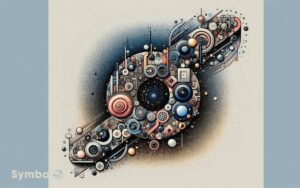Why Are Snakes Used in Medical Symbols? Historical Origins!
Snakes symbolize regeneration, protection, and healing across many cultures, grounding their presence in medical symbols.
In Greek mythology, they’re closely linked to Asclepius, the deity of healing, epitomized by the Rod of Asclepius: a single serpent coiled around a staff, representing medical balance and authority.
This emblem, embodying ancient beliefs in snakes‘ power for renewal, dominates modern medicine’s imagery, evident in hospital logos and health campaigns. It reflects the intricate balance between disease and cure, underscoring medicine’s dual nature.
Exploring this ancient connection offers you profound insights into the cultural dimensions shaping contemporary medical symbolism.

Key Takeaways
Ancient Healing Practices
In exploring the roots of the association between snakes and medical symbols, it’s crucial to delve into ancient healing practices, where serpents often embodied regeneration and rejuvenation due to their skin-shedding process.
This natural phenomenon led many ancient cultures to view snakes as symbols of immortality and healing.
You’ll find that in ancient Egyptian medicine, the serpent was a symbol of protection and was believed to ward off evil spirits, thus safeguarding the health of the pharaohs and priests.
Similarly, in Greek tradition, serpents were associated with healing deities and were thought to possess an intrinsic knowledge of medicinal herbs.
These historical perspectives highlight a profound respect and reverence for serpents, underpinning their enduring symbol in the medical field.
The Rod of Asclepius
You’ll find the Rod of Asclepius, a single serpent entwined around a staff, deeply rooted in Greek mythology, symbolizing healing and medicine.
Its emergence as a symbol isn’t arbitrary but reflects a complex interplay of mythological narratives and the ancient understanding of medicine and healing.
In modern contexts, this symbol’s adoption by medical organizations underscores its enduring relevance and the symbolic continuity of healing practices through centuries.
Origins in Greek Mythology
Delving into the origins of the Rod of Asclepius unveils its deep roots in Greek mythology, where it symbolizes healing and medicine. This emblem’s genesis is intricately tied to Asclepius, the deity of healing and medicine.
Your exploration into this subject reveals:
- Asclepius’ Birth: Born from Apollo and Coronis, Asclepius’ lineage itself is steeped in divine connections to health and disease.
- Divine Intervention: Asclepius’ acquisition of healing powers is attributed to being raised by the centaur Chiron, who taught him the art of medicine.
- Symbolic Representation: The snake, embodying regeneration and renewal due to its ability to shed its skin, becomes a potent symbol when entwined around Asclepius’ staff, representing the duality of medicine’s power to both harm and heal.
This scholarly analysis elucidates the symbolic depth and cultural heritage encapsulated within the Rod of Asclepius.
Symbolism of Healing
The Rod of Asclepius, with its singular serpent coiled around a staff, serves as a universally recognized emblem of healing and medicine, reflecting a profound symbolism rooted in rejuvenation and the dual nature of medical intervention.
This ancient symbol encapsulates the essence of healing, not merely as an act of curing physical ailments but as a comprehensive process that encompasses both harm and remedy.
The serpent, often associated with regeneration due to its skin-shedding, signifies renewal and the cyclical nature of health and disease.
Conversely, the staff, a symbol of authority and guidance, underscores the pivotal role of the medical practitioner in navigating the complex journey towards healing.
Together, they articulate a balanced perspective on medicine: a field fraught with challenges yet imbued with the potential for transformation and renewal.
Modern Medical Use
Reflecting its ancient roots, the Rod of Asclepius remains a central symbol in contemporary medical practice, symbolizing the enduring principles of healing and healthcare.
This emblem, featuring a single serpent entwined around a staff, is deeply ingrained in the identity and ethos of the medical profession.
Here’s how it manifests in modern contexts:
- Medical Institutions: Many hospitals and healthcare organizations incorporate the Rod of Asclepius in their logos, signifying a commitment to health and healing.
- Professional Identity: Medical practitioners often wear pins or badges depicting this symbol, denoting their dedication to the Hippocratic Oath and patient care.
- Public Health Messaging: Governments and health agencies use the symbol in public health campaigns, emphasizing its role in promoting wellness and disease prevention.
This enduring symbol serves as a bridge, connecting the medical community with its ancient heritage and guiding principles.
Symbol of Renewal
Snakes, often seen winding around the staff of Asclepius or the caduceus, symbolize renewal due to their skin-shedding process, which metaphorically represents rejuvenation and healing.
This natural phenomenon, where snakes periodically shed their old skin for new growth, mirrors the human desire for renewal and recovery from ailments.
In the medical context, this emblematic representation underscores the profession’s goal: to restore health and foster regeneration.
The act of shedding, thus, becomes a powerful metaphor for the transformative process of healing, suggesting that just as snakes discard their worn-out skins, medical interventions aim to shed disease and affliction, enabling the emergence of a rejuvenated state.
This symbolism, steeped in antiquity, continues to resonate, reinforcing the timeless nature of renewal as a central tenet of medicine.
Dual Nature of Medicine
Exploring the dual nature of medicine reveals its capacity to both heal and harm, embodying a complex interplay between beneficence and maleficence inherent in medical interventions.
You’ll find that:
- Beneficence underscores the primary intention of medicine to promote well-being, alleviate suffering, and restore health. This principle drives the development of treatments and therapies designed to cure diseases and improve quality of life.
- Maleficence, on the other hand, acknowledges the potential for medical interventions to cause harm, whether through side effects, medical errors, or the ethical dilemmas posed by certain treatments. The challenge lies in balancing these risks against the potential benefits.
- Informed Consent is critical in navigating this duality, ensuring that patients are fully aware of the potential risks and benefits, thereby empowering them to make decisions aligned with their values and best interests.
Influence of Greek Mythology
You must consider the profound impact Greek mythology exerts on the realm of medical symbolism, particularly through the figure of Asclepius, the god of healing.
His emblem, the Rod of Asclepius, encapsulates the confluence of medicine and serpentine symbolism, emphasizing renewal and healing.
Conversely, the Caduceus, often misinterpreted as a medical symbol, originates from a distinct narrative, highlighting the intricacies of mythological influence on contemporary medical insignias.
Asclepius: God of Healing
In the realm of Greek mythology, Asclepius, the god of healing, significantly influenced the symbolic use of snakes in medical emblems.
His story embodies the intersection of divine intervention and the natural world, encapsulating the ancient belief in the healing powers inherent in nature, particularly serpents.
The key aspects of Asclepius’s influence include:
- Mythological Significance: Asclepius’s divine lineage positioned him as a pivotal figure in the pantheon, embodying healing and medical prowess.
- Cultural Practices: Temples dedicated to Asclepius became centers for medical treatment, where snakes roamed freely, believed to possess therapeutic properties.
- Philosophical Implications: The god’s association with snakes symbolized renewal and the transformative power of medicine, bridging the gap between mortal understanding and divine wisdom.
This intricate relationship underscores the depth of symbolic meaning snakes have carried through history, particularly in the medical field.
Rod of Asclepius Symbolism
One cannot overlook the Rod of Asclepius’s symbolism, a quintessential emblem derived from Greek mythology, embodying the ancient intertwining of healing and serpents.
This symbol, a single serpent entwined around a staff, is steeped in significance, reflecting profound elements of renewal, health, and the cyclical nature of life.
| Aspect | Interpretation | Relevance |
|---|---|---|
| Serpent | Renewal, rebirth | Healing’s cyclical process |
| Staff | Stability, support | Foundation of health |
| Entwinement | Harmony between elements | Balance in medical practice |
| Singular | Focus, unity | Singular purpose in healing |
| Mythological | Connection to divinity, Asclepius | Divine protection, guidance |
Understanding the Rod of Asclepius involves recognizing its roots in mythology while appreciating its timeless relevance in the medical field, an emblem that transcends mere decoration to embody the essence of healing itself.
Caduceus: Misinterpreted Emblem
Despite its widespread association with the medical profession, the Caduceus, featuring two serpents intertwined around a winged staff, stands as a historically misinterpreted emblem deeply rooted in Greek mythology.
This symbol’s true origins and implications might surprise you:
- Hermes’ Emblem: Originally, the Caduceus was the staff of Hermes, the Greek god of commerce, thieves, and heraldry not healing.
- Misinterpretation: Its mistaken link to medicine likely stems from confusion with the Rod of Asclepius, which does symbolize healing and is correctly associated with medical fields.
- Symbolic Misuse: The visual appeal and historical prestige of the Caduceus have overshadowed its genuine mythological roots, leading to its widespread but inaccurate adoption in medical contexts.
Understanding this distinction enriches your grasp of how symbols evolve and acquire new meanings, sometimes far removed from their original intent. This process highlights the fluid and dynamic nature of language and culture, as context and societal shifts breathe new life into old symbols. By examining symbolism and its deeper meanings, we gain insight into how collective human experiences shape the way we communicate abstract ideas. Ultimately, it underscores the power of shared interpretation in creating connections across time and space.
Worldwide Cultural Significance
Across cultures, snakes hold a complex and multifaceted significance in medical symbolism, reflecting a rich tapestry of beliefs, values, and historical practices that span the globe.
In many traditions, these creatures embody regeneration and healing, owing to their ability to shed their skin and emerge anew.
This symbolizes renewal and the transformative power of medicine. Moreover, their dual nature, representing both venom and antidote, underscores the delicate balance between disease and cure.
Ancient civilizations, such as the Greeks with Asclepius, the god of healing, who’s often depicted with a snake, illustrate the deep-rooted association between serpents and health.
This profound symbolism transcends mere iconography, encapsulating the essence of life’s cyclical nature and the perpetual quest for healing and rejuvenation within the human experience.
Modern Medical Emblems
Building on the historical roots of snakes in medical symbolism, contemporary medical emblems continue to reflect this rich legacy through their design and widespread recognition.
You’ll notice that modern symbols often incorporate snakes in one of three primary ways:
- The Rod of Asclepius: Featuring a single snake wrapped around a staff, this emblem represents healing and medicine, symbolizing the Greek god Asclepius’s association with these realms.
- The Caduceus: Characterized by two snakes winding around a winged staff, it’s mistakenly used in medical contexts due to its historical association with Hermes, signifying commerce and negotiation.
- Pharmacy Symbols: Many pharmacies adopt snake motifs, combining elements of the Rod of Asclepius and local cultural symbols to denote health and healing.
These emblems serve as a bridge, connecting the ancient reverence for snakes in healing to modern medical practice, underscoring continuity and evolution in medical symbolism.
Conclusion
You’ve journeyed from the ancient healing practices to the modern medical emblems, uncovering the serpentine path that intertwines medicine and snakes.
The Rod of Asclepius, a beacon of health and renewal, symbolizes the dual nature of medicine its power to heal and harm. Like Prometheus’ gift of fire to humanity, snakes in medical symbols encapsulate the duality and potential of medical science.
This rich tapestry, woven from threads of mythology and global culture, underlines the enduring legacy and profound significance of snakes in the medical realm.






